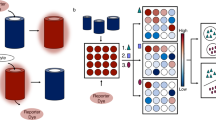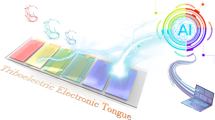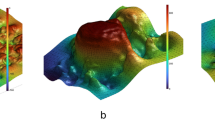Abstract
Humans can taste and identify numerous comestibles by combining a small variety of taste receptor cells that exhibit broad-spectrum sensitivity with information processing based on pattern recognition. Recently, we have developed a biosensing strategy called the “chemical tongue”, which mimics the taste system by employing polymeric materials containing various chemical structures labeled with environment-responsive fluorophores in conjunction with statistical techniques such as multivariate analysis and machine learning. In this review, the author outlines the design of polymer-based chemical tongues using polyamino acids, DNAs, and polyion complexes and their applications with various complex biological samples, including cell suspensions, cell secretions, and therapeutic antibodies. The chemical-tongue strategy is capable of recognizing biological samples in a unique manner that does not, in contrast to conventional approaches, rely on specific interactions, thereby potentially opening avenues for unexplored uses of polymers in a wide range of research areas.
This is a preview of subscription content, access via your institution
Access options
Subscribe to this journal
Receive 12 print issues and online access
$259.00 per year
only $21.58 per issue
Buy this article
- Purchase on Springer Link
- Instant access to full article PDF
Prices may be subject to local taxes which are calculated during checkout








Similar content being viewed by others
References
Holford TRJ, Davis F, Higson SPJ. Recent trends in antibody based sensors. Biosens Bioelectron. 2012;34:12–24.
Kirsch J, Siltanen C, Zhou Q, Revzin A, Simonian A. Biosensor technology: recent advances in threat agent detection and medicine. Chem Soc Rev. 2013;42:8733–68.
Califf RM. Biomarker definitions and their applications. Exp Biol Med. 2018;243:213–21.
Prasad B, Achour B, Artursson P, Hop CECA, Lai Y, Smith PC, et al. Toward a consensus on applying quantitative liquid chromatography-tandem mass spectrometry proteomics in translational pharmacology research: a white paper. Clin Pharmacol Ther. 2019;106:525–43.
Yarmolinsky DA, Zuker CS, Ryba NJP. Common sense about taste: from mammals to insects. Cell. 2009;139:234–44.
Roper SD, Chaudhari N. Taste buds: cells, signals and synapses. Nat Rev Neurosci. 2017;18:485–97.
Rakow NA, Suslick KS. A colorimetric sensor array for odour visualization. Nature. 2000;406:710–3.
Zhang C, Suslick KS. A colorimetric sensor array for organics in water. J Am Chem Soc. 2005;127:11548–9.
Rakow NA, Sen A, Janzen MC, Ponder JB, Suslick KS. Molecular recognition and discrimination of amines with a colorimetric array. Angew Chem, Int Ed. 2005;44:4528–32.
Lim SH, Musto CJ, Park E, Zhong W, Suslick KS. A colorimetric sensor array for detection and identification of sugars. Org Lett. 2008;10:4405–8.
Li Z, Askim JR, Suslick KS. The optoelectronic nose: colorimetric and fluorometric sensor arrays. Chem Rev. 2019;119:231–92.
You C-C, Miranda OR, Gider B, Ghosh PS, Kim I-B, Erdogan B, et al. Detection and identification of proteins using nanoparticle-fluorescent polymer “chemical nose” sensors. Nat Nanotechnol. 2007;2:318–23.
Miranda OR, You C-C, Phillips R, Kim I-B, Ghosh PS, Bunz UHF, et al. Array-based sensing of proteins using conjugated polymers. J Am Chem Soc. 2007;129:9856–7.
Miranda OR, Creran B, Rotello VM. Array-based sensing with nanoparticles: “chemical noses” for sensing biomolecules and cell surfaces. Curr Opin Chem Biol. 2010;14:728–36.
Geng Y, Peveler WJ, Rotello VM. Array‐based “Chemical Nose” sensing in diagnostics and drug discovery. Angew Chem, Int Ed. 2019;58:5190–5200.
Han J, Bender M, Seehafer K, Bunz UHF. Identification of white wines by using two oppositely charged poly(p-phenyleneethynylene)s individually and in complex. Angew Chem Int Ed. 2016;55:7689–92.
Han J, Ma C, Wang B, Bender M, Bojanowski M, Hergert M, et al. A hypothesis-free sensor array discriminates whiskies for brand, age, and taste. Chem. 2017;2:817–24.
Wang B, Han J, Zhang H, Bender M, Biella A, Seehafer K, et al. Detecting counterfeit brandies. Chem—Eur J. 2018;24:17361–6.
Suzuki S, Sawada T, Serizawa T. Identification of water-soluble polymers through discrimination of multiple optical signals from a single peptide sensor. ACS Appl Mater Interfaces. 2021;13:55978–87.
Wu D, Schanze KS. Protein induced aggregation of conjugated polyelectrolytes probed with fluorescence correlation spectroscopy: application to protein identification. ACS Appl Mater Interfaces. 2014;6:7643–51.
Xu S, Lu X, Yao C, Huang F, Jiang H, Hua W, et al. A visual sensor array for pattern recognition analysis of proteins using novel blue-emitting fluorescent gold nanoclusters. Anal Chem. 2014;86:11634–9.
Chang N, Lu Y, Mao J, Yang J, Li M, Zhang S, et al. Ratiometric fluorescence sensor arrays based on quantum dots for detection of proteins. Analyst. 2016;141:2046–52.
Xu S, Gao T, Feng X, Fan X, Liu G, Mao Y, et al. Near infrared fluorescent dual ligand functionalized Au NCs based multidimensional sensor array for pattern recognition of multiple proteins and serum discrimination. Biosens Bioelectron. 2017;97:203–7.
Xu S, Wu Y, Sun X, Wang Z, Luo X. A multicoloured Au NCs based cross-reactive sensor array for discrimination of multiple proteins. J Mater Chem B. 2017;5:4207–13.
Xu S, Su Z, Zhang Z, Nie Y, Wang J, Ge G, et al. Rapid synthesis of nitrogen doped carbon dots and their application as a label free sensor array for simultaneous discrimination of multiple proteins. J Mater Chem B. 2017;5:8748–53.
Pandit S, Banerjee T, Srivastava I, Nie S, Pan D. Machine learning-assisted array-based biomolecular sensing using surface-functionalized carbon dots. ACS Sens. 2019;4:2730–7.
Tomita S, Ishihara S, Kurita R. Biomimicry recognition of proteins and cells using a small array of block copolymers appended with amino acids and fluorophores. ACS Appl Mater Interfaces. 2019;11:6751–8.
Zhang Y, Görner H. Photoprocesses of xanthene dyes bound to lysozyme or serum albumin. Photochem Photobiol. 2009;85:677–85.
Chen H, Ahsan SS, Santiago-Berrios MB, Abruña HD, Webb WW. Mechanisms of quenching of Alexa fluorophores by natural amino acids. J Am Chem Soc. 2010;132:7244–5.
Tomita S, Ishihara S, Kurita R. Environment-sensitive turn-on fluorescent polyamino acid: fingerprinting protein populations with post-translational modifications. ACS Appl Mater Interfaces. 2017;9:22970–6.
Sugai H, Tomita S, Ishihara S, Kurita R. Fingerprint-based protein identification in cell culture medium using environment-sensitive turn-on fluorescent polymer. Sens Mater. 2019;31:1–11.
Zhuang Y-D, Chiang P-Y, Wang C-W, Tan K-T. Environment‐sensitive fluorescent turn‐on probes targeting hydrophobic ligand‐binding domains for selective protein detection. Angew Chem, Int Ed. 2013;52:8214–8128.
Majorek KA, Porebski PJ, Dayal A, Zimmerman MD, Jablonska K, Stewart AJ, et al. Structural and immunologic characterization of bovine, horse, and rabbit serum albumins. Mol Immunol. 2012;52:174–82.
Tomita, S, Kusada, H, Kojima, N, Ishihara, S, Miyazaki, K, Tamaki, H et al. Polymer-based chemical nose systems for optical pattern recognition of gut microbiota. ChemRxiv (2020). https://doi.org/10.26434/chemrxiv.12649826.
Sharma TK, Bruno JG, Dhiman A. ABCs of DNA aptamer and related assay development. Biotechnol Adv. 2017;35:275–301.
Lu Y, Liu Y, Zhang S, Wang S, Zhang S, Zhang X. Aptamer-based plasmonic sensor array for discrimination of proteins and cells with the naked eye. Anal Chem. 2013;85:6571–4.
Sun W, Lu Y, Mao J, Chang N, Yang J, Liu Y. Multidimensional sensor for pattern recognition of proteins based on DNA–gold nanoparticles conjugates. Anal Chem. 2015;87:3354–9.
Li C, Yang Y, Wei L, Wang X, Wang Z, Yin Y, et al. An array-based approach to determine different subtype and differentiation of non-small cell lung cancer. Theranostics. 2015;5:62.
Wei X, Chen Z, Tan L, Lou T, Zhao Y. DNA-catalytically active gold nanoparticle conjugates-based colorimetric multidimensional sensor array for protein discrimination. Anal Chem. 2017;89:556–9.
Wu S, Han Y, Wang L, Li J, Sun Z, Zhang M, et al. Sensor array fabricated with nanoscale metal-organic frameworks for the histopathological examination of colon cancer. Anal Chem. 2019;91:10772–8.
Pei H, Li J, Lv M, Wang J, Gao J, Lu J, et al. A graphene-based sensor array for high-precision and adaptive target identification with ensemble aptamers. J Am Chem Soc. 2012;134:13843–9.
Tomita S, Ishihara S, Kurita R. A multi-fluorescent DNA/graphene oxide conjugate sensor for signature-based protein discrimination. Sensors. 2017;17:2194.
Hizir MS, Robertson NM, Balcioglu M, Alp E, Rana M, Yigit MV. Universal sensor array for highly selective system identification using two-dimensional nanoparticles. Chem Sci. 2017;8:5735–45.
Nandu N, Hizir MS, Yigit MV. Systematic investigation of two-dimensional DNA nanoassemblies for construction of a nonspecific sensor array. Langmuir. 2018;34:14983–92.
Tomita S, Sugai H, Mimura M, Ishihara S, Shiraki K, Kurita R. Optical fingerprints of proteases and their inhibited complexes provided by differential cross-reactivity of fluorophore-labeled single-stranded DNA. ACS Appl Mater Interfaces. 2019;11:47428–36.
Okada M, Sugai H, Tomita S, Kurita R. A multichannel pattern-recognition-based protein sensor with a fluorophore-conjugated single-stranded DNA set. Sensors. 2020;20:5110.
De M, Rana S, Akpinar H, Miranda OR, Arvizo RR, Bunz UHF, et al. Sensing of proteins in human serum using conjugates of nanoparticles and green fluorescent protein. Nat Chem. 2009;1:461–5.
Moyano DF, Rana S, Bunz UHF, Rotello VM. Gold nanoparticle-polymer/biopolymer complexes for protein sensing. Faraday Discuss. 2011;152:33–42.
Tomita S, Yoshimoto K. Polyion complex libraries possessing naturally occurring differentiation for pattern-based protein discrimination. Chem Commun. 2013;49:10430–2.
Tomita S, Soejima T, Shiraki K, Yoshimoto K. Enzymatic fingerprinting of structurally similar homologous proteins using polyion complex library constructed by tuning PEGylated polyamine functionalities. Analyst. 2014;139:6100–3.
Tomita S, Niwa O, Kurita R. Artificial modification of an enzyme for construction of cross-reactive polyion complexes to fingerprint signatures of proteins and mammalian cells. Anal Chem. 2016;88:9079–86.
Peveler WJ, Landis RF, Yazdani M, Day JW, Modi R, Carmalt CJ, et al. A rapid and robust diagnostic for liver fibrosis using a multichannel polymer sensor array. Adv Mater. 2018;30:1800634.
Xu S, Li W, Zhao X, Wu T, Cui Y, Fan X, et al. Ultrahighly efficient and stable fluorescent gold nanoclusters coated with screened peptides of unique sequences for effective protein and serum discrimination. Anal Chem. 2019;91:13947–52.
Lin E, Cao T, Nagrath S, King MR. Circulating tumor cells: diagnostic and therapeutic applications. Annu Rev Biomed Eng. 2018;20:329–52.
Solier C, Langen H. Antibody‐based proteomics and biomarker research—current status and limitations. Proteomics. 2014;14:774–83.
Bajaj A, Miranda OR, Kim I-B, Phillips RL, Jerry DJ, Bunz UHF, et al. Detection and differentiation of normal, cancerous, and metastatic cells using nanoparticle-polymer sensor arrays. Proc Natl Acad Sci USA. 2009;106:10912–6.
El-Boubbou K, Zhu DC, Vasileiou C, Borhan B, Prosperi D, Li W, et al. Magnetic glyco-nanoparticles: a tool to detect, differentiate, and unlock the glyco-codes of cancer via magnetic resonance imaging. J Am Chem Soc. 2010;132:4490–9.
Jiang Z, Le NDB, Gupta A, Rotello VM. Cell surface-based sensing with metallic nanoparticles. Chem Soc Rev. 2015;44:4264–74.
Rana S, Elci SG, Mout R, Singla AK, Yazdani M, Bender M, et al. Ratiometric array of conjugated polymers-fluorescent protein provides a robust mammalian cell sensor. J Am Chem Soc. 2016;138:4522–9.
Tao Y, Li M, Auguste DT. Pattern-based sensing of triple negative breast cancer cells with dual-ligand cofunctionalized gold nanoclusters. Biomaterials. 2017;116:21–33.
Sugai H, Tomita S, Kurita R. Pattern-recognition-based sensor arrays for cell characterization: from materials and data analyses to biomedical applications. Anal Sci. 2020;36:923–34.
Bai H, Liu Z, Zhang T, Du J, Zhou C, He W, et al. Multifunctional supramolecular assemblies with aggregation-induced emission (AIE) for cell line identification, cell contamination evaluation, and cancer cell discrimination. ACS Nano. 2020;14:7552–63.
Rana S, Singla AK, Bajaj A, Elci SG, Miranda OR, Mout R, et al. Array-based sensing of metastatic cells and tissues using nanoparticle-fluorescent protein conjugates. ACS Nano. 2012;6:8233–40.
Le NDB, Yesilbag Tonga G, Mout R, Kim S-T, Wille ME, Rana S, et al. Cancer cell discrimination using host-guest “doubled” arrays. J Am Chem Soc. 2017;139:8008–12.
Sugai H, Tomita S, Ishihara S, Kurita R. One-component array based on a dansyl-modified polylysine: generation of differential fluorescent signatures for the discrimination of human cells. ACS Sens. 2019;4:827–31.
Holliday DL, Speirs V. Choosing the right cell line for breast cancer research. Breast Cancer Res. 2011;13:215.
Singh VK, Kalsan M, Kumar N, Saini A, Chandra R. Induced pluripotent stem cells: applications in regenerative medicine, disease modeling, and drug discovery. Front Cell Dev Biol. 2015;3:2.
Fang Y, Eglen RM. Three-dimensional cell cultures in drug discovery and development. SLAS Discov. 2017;22:456–72.
Brown KJ, Formolo CA, Seol H, Marathi RL, Duguez S, An E, et al. Advances in the proteomic investigation of the cell secretome. Expert Rev Proteom. 2012;9:337–45.
Makridakis M, Roubelakis MG, Vlahou A. Stem cells: insights into the secretome. Biochim Biophys Acta. 2013;1834:2380–4.
Brandi J, Manfredi M, Speziali G, Gosetti F, Marengo E, Cecconi D. Proteomic approaches to decipher cancer cell secretome. Semin Cell Dev Biol. 2018;78:93–101.
Stühler K. The secrets of protein secretion: what are the key features of comparative secretomics? Expert Rev Proteom. 2020;17:785–7.
Tomita S, Sakao M, Kurita R, Niwa O, Yoshimoto K. A polyion complex sensor array for markerless and noninvasive identification of differentiated mesenchymal stem cells from human adipose tissue. Chem Sci. 2015;6:5831–6.
Tomita S, Nomoto H, Yoshitomi T, Iijima K, Hashizume M, Yoshimoto K. Noninvasive fingerprinting-based tracking of replicative cellular senescence using a colorimetric polyion complex array. Anal Chem. 2018;90:6348–52.
Sugai H, Tomita S, Ishihara S, Yoshioka K, Kurita R. Microfluidic sensing system with a multichannel surface plasmon resonance chip: damage-free characterization of cells by pattern recognition. Anal Chem. 2020;92:14939–46.
Ronaldson-Bouchard K, Vunjak-Novakovic G. Organs-on-a-chip: a fast track for engineered human tissues in drug development. Cell Stem Cell. 2018;22:310–24.
Grilo AL, Mantalaris A. The increasingly human and profitable monoclonal antibody market. Trends Biotechnol. 2019;37:9–16.
Elgundi Z, Reslan M, Cruz E, Sifniotis V, Kayser V. The state-of-play and future of antibody therapeutics. Adv Drug Deliv Rev. 2017;122:2–19.
Tomita S, Matsuda A, Nishinami S, Kurita R, Shiraki K. One-step identification of antibody degradation pathways using fluorescence signatures generated by cross-reactive DNA-based arrays. Anal Chem. 2017;89:7818–22.
Acknowledgements
The author would like to express his gratitude to Sayaka Ishihara (National Institute of Advanced Industrial Science and Technology) and Prof. Hiroka Sugai (University of Tsukuba), as well as his other past and present colleagues for their invaluable contributions to this focus review. The author is deeply indebted to Prof. Ryoji Kurita (National Institute of Advanced Industrial Science and Technology), Prof. Osamu Niwa (Saitama Institute of Technology), Prof. Keitaro Yoshimoto (The University of Tokyo), and Prof. Kentaro Shiraki (University of Tsukuba) for their continuous encouragement and constructive discussions. This work was financially supported by JSPS KAKENHI grants JP26810074, JP16K14043, JP17H04884 and JP20H02774, as well as AMED grant JP21wm0425004.
Author information
Authors and Affiliations
Corresponding author
Ethics declarations
Conflict of interest
The author declares no competing interests.
Additional information
Publisher’s note Springer Nature remains neutral with regard to jurisdictional claims in published maps and institutional affiliations.
Rights and permissions
About this article
Cite this article
Tomita, S. Chemical tongues: biomimetic recognition using arrays of synthetic polymers. Polym J 54, 851–862 (2022). https://doi.org/10.1038/s41428-022-00636-w
Received:
Revised:
Accepted:
Published:
Issue Date:
DOI: https://doi.org/10.1038/s41428-022-00636-w



